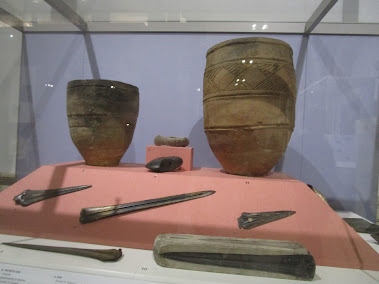I upgraded my Aunt Loretta's Family Finder test at
Family Tree DNA to include a full sequence mtDNA test. I received the results of her test yesterday which was just short of 5 weeks from the time they began processing her kit.
The main outcome of the test was learning what my Aunt's mtDNA haplogroup is. It's U5a1a2a. Haplogroups can be specific to certain areas. The U5 haplogroup is widespread in Europe, but thankfully not as common as the H haplogroups. U5 is found in low frequencies throughout Europe.
You can watch a video about her results at this link:
https://www.familytreedna.com/mtdna-journey-videos/5fd3f3cac9e77c0001d6bf09One of the things I hoped to accomplish with this test was to find some matches from the area my Mullen/Huvane family came from in Ireland. Sadly because of record losses in Ireland it's very difficult to trace families back beyond a few generations. I was hoping that my Aunt might have some matches from the area where her maternal Grandmother Helen Mullen-Mason was born.
My Aunt does have matches who have have identified their maternal direct line as Irish, but they are not from my familys area. It's very likely that few women with roots from south Co. Mayo have tested.
The map feature at Family Tree DNA is very helpful for sorting matches out because I'm looking for matches from the area my family lived.
This map shows full sequence matches who have identified a place in Ireland where their direct maternal line traces back to. The yellow pins show where 2 step mismatches' ancestors are said to be from. My Aunt doesn't match anyone closer than 2 steps. Our common shared ancestor could have lived over 1,000 years ago. Since I don't recognized any of the surnames of places that is possible. Three step mismatches are green pins. Those could be even farther back in time.

The matches closest to the area the Huvane/Rhatighan family lived would be those with a perfect match on HVR1 only, they have ancestors from Co. Galway. The Huvane family lived on the border between Co. Galway and Co. Mayo.

More on the Haplogroup
According to
Eupedia my Aunt's haplogroup can be found in the following countries:
"U5a1a2: found in England, Scandinavia, Central Europe and Turkey / found in Bell Beaker Germany, in the Unetice culture, in EBA England, in MBA Wales, and in Bronze Age Poland.
Since my Aunt and I tend to get Scandinavian atDNA predictions it could be that her direct female line goes back to the Viking invasions since her haplogroup appears to stem from Finland?
Here is a heat map from Eupedia showing the distribution of the U5 haplogroup. The darker colors show the highest concentrations of this haplogroup. I'm leaning toward thinking there is a Scandinavian Viking link somewhere?
Here is an illustration of my Grandmother's mtDNA U5a1a2 line of descent:
Cousin matches 23andMe Haplogroups
I've looked at my
23andme close cousin matches and collected their haplogroups. A first cousin once removed has tested at
23andMe. Her haplogroup HV6 is very interesting because the highest concentration of this haplogroup is in Eastern Europe. This match's maternal Grandmother was Mary Kurta-Kappel, she was my Great-Grandmother. Mary was born in what is now the eastern border area of Austria; in what is now Inzenhof, Burgenland, Austria. This area used to be in Hungary.
Eupedia lists the following countries where this haplogroup can be found:
HV6 : found in Iran, Russia, Slovakia and Britain / found in Bronze Age Poland and among the Tian Shan Huns.
I've had Slovakian predicted as one of my admixtures on the atDNA test. There were Huns in Hungary so that could be another possible source?
Below is a heat map showing the distribution of the HV6 haplogroup:
Here is an illustration of my paternal Great-Grandmother Mary Kurta-Kappel's direct maternal line:
Mary Kurta-Kappel's haplogroup is very useful because it narrows her maternal origins to continental Europe, and leads to eastern Europe. Unlike a haplogroup such as H1 thru H3 which are found all over Europe, and the British Isles, this haplogroup is found in fewer places. I didn't know where this line came from this would be a good hint.
K2a2a Haplogroup
Another interesting haplogroup from a
23andme match is K2a2a. This match is a second cousin and is a direct maternal line descendant of my Great-Grandmother Isis Browning-Forgey. This maternal line of my family shares the K2 haplogroup with Thomas Jefferson.
The K2a haplogroup is common among Ashkenazi Jews. My my Great-Grandmother's direct maternal line likely goes back to Germany. It is possible she had Ashkenazi ancestors?
This is what Eupedia says about the mtDNA haplogroup K2a2a:
"Ashkenazi Jews are the ethnic groups with the highest percentage of K lineages today : 32% in average, and up to 50% among Ashkenazi Jews from Germany. There are only three typically Jewish subclades of K: K1a1b1a, K1a9, and K2a2a."
Here is an illustration of my Great-Grandmother Isis Browning's maternal direct line:
My mother's atDNA admixture predictions sometimes show trace Ashkenazi Jewish. It is possible we had some Jewish ancestry in our German lines.
Concluding Thoughts
So far our mtDNA haplogroups have been the most informative pointing to possible areas of origin of our direct maternal lines. As far as my Aunt's full sequence mtDNA test we need closer matches in order to use the test to confirm our paper trail and extend our tree. I think the mtDNA test results are interesting and recommend testing if you're interested in delving deeper into your family history.
My collected haplogroups recorded at DNA Painter:





















